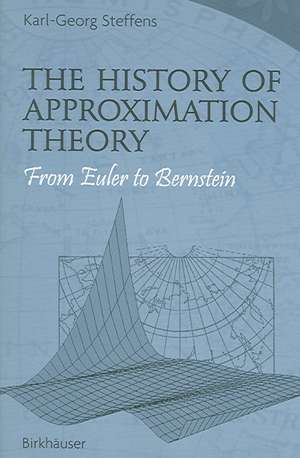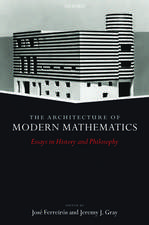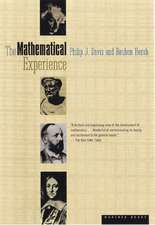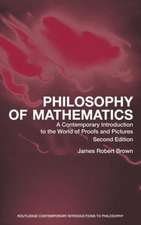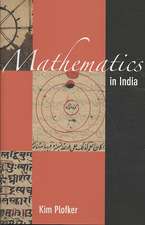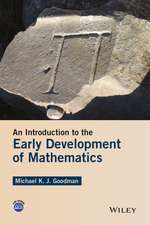The History of Approximation Theory: From Euler to Bernstein
Autor Karl-Georg Steffens George A. Anastassiouen Limba Engleză Paperback – 16 dec 2005
Preț: 385.08 lei
Nou
Puncte Express: 578
Preț estimativ în valută:
73.68€ • 76.94$ • 60.85£
73.68€ • 76.94$ • 60.85£
Carte tipărită la comandă
Livrare economică 15-29 aprilie
Preluare comenzi: 021 569.72.76
Specificații
ISBN-13: 9780817643539
ISBN-10: 0817643532
Pagini: 219
Ilustrații: XIX, 219 p. 12 illus.
Dimensiuni: 155 x 235 x 12 mm
Greutate: 0.35 kg
Ediția:2006
Editura: Birkhäuser Boston
Colecția Birkhäuser
Locul publicării:Boston, MA, United States
ISBN-10: 0817643532
Pagini: 219
Ilustrații: XIX, 219 p. 12 illus.
Dimensiuni: 155 x 235 x 12 mm
Greutate: 0.35 kg
Ediția:2006
Editura: Birkhäuser Boston
Colecția Birkhäuser
Locul publicării:Boston, MA, United States
Public țintă
ResearchCuprins
Forerunners.- Pafnuti Lvovich Chebyshev.- The Saint Petersburg Mathematical School.- Development Outside Russia.- Constructive Function Theory: Kharkiv.
Recenzii
From the reviews:
"This book aims to tell the historical evolution of the methods and results of approximation theory, starting from the work of Euler in 1777 on minimizing distance errors in maps of Russia, and of Laplace in 1843 on finding the best ellipsoid for the earth, and ending with the work of Bernstein. The central character in the book is Chebyshev (1821–1894) and the Saint Petersburg Mathematical School he created.... [The] book contains much interesting material and has certainly motivated me to learn more about the subject and its history. No book can wish for more and so I recommend the book to anyone interested in approximation theory or in the history of mathematics." —MAA Reviews
"The author describes the early stage of development of approximation theory. … The famous Russian school founded by … Chebyshev is presented in full. … contributions of German and French mathematicians to both Weierstrass and Chebyshev directions are illuminated … . All this is supported with quotations from documents, letters, speeches, early publications, and memoirs. … Undoubtedly, the author has succeeded in catching the spirit both of the Russian atmosphere of that time and of the depth and richness of the human relationships … ." (B. Boyanov, Mathematical Reviews, Issue 2006 j)
“The discussion of mathematical results and ideas constitutes the main part of the book—always accompanied by moving stories, marked by devotion to science, by humanity, and often by the cruelty of the political turbulence of Russian history. Undoubtedly, the author has succeeded in catching the spirit both of the Russian atmosphere of that time and of the depth and richness of the human relationships of the people involved.”(MATHEMATICAL REVIEWS)
"This nice little book is devoted to the early development of approximation theory. It mainly concentrates on the role of Russianmathematicians but confronts it with the development of approximation theory in the West … The book will be of interest for historians of mathematics and for specialists in approximation theory." (EMS Newsletter, September, 2006)
"The storie is vivid, rich and touching. Many interesting details from the life, education and work of the unsurpassed master of classical analysis, Sergei Natanovich Bernstein, are given. Some of them are published for the first time and come from personal reminiscences of his pupils, close friends and collaboratiors. ...All this is supported with quotations from documents, letters speeches, easrly publications, and memiors. ... Undoubtedly, the author has succeeded in catching the spirit both of the Russian atmosphere of that time and of the depth and richness of the human relationships of the people involved." (American Mathematical Society)
"The book’s stated goal is ‘to describe the early development of approximation theory… (until) 1919….’ I learned lots of new names, new stories, and new connections. … In conclusion, this book is necessary … for studying the history of approximation theory. … it does contain plenty of useful information that is not readily or not at all available elsewhere." (Paul Nevai, SIAM Review, Vol. 49 (1), 2007)
"This book aims to tell the historical evolution of the methods and results of approximation theory, starting from the work of Euler in 1777 on minimizing distance errors in maps of Russia, and of Laplace in 1843 on finding the best ellipsoid for the earth, and ending with the work of Bernstein. The central character in the book is Chebyshev (1821–1894) and the Saint Petersburg Mathematical School he created.... [The] book contains much interesting material and has certainly motivated me to learn more about the subject and its history. No book can wish for more and so I recommend the book to anyone interested in approximation theory or in the history of mathematics." —MAA Reviews
"The author describes the early stage of development of approximation theory. … The famous Russian school founded by … Chebyshev is presented in full. … contributions of German and French mathematicians to both Weierstrass and Chebyshev directions are illuminated … . All this is supported with quotations from documents, letters, speeches, early publications, and memoirs. … Undoubtedly, the author has succeeded in catching the spirit both of the Russian atmosphere of that time and of the depth and richness of the human relationships … ." (B. Boyanov, Mathematical Reviews, Issue 2006 j)
“The discussion of mathematical results and ideas constitutes the main part of the book—always accompanied by moving stories, marked by devotion to science, by humanity, and often by the cruelty of the political turbulence of Russian history. Undoubtedly, the author has succeeded in catching the spirit both of the Russian atmosphere of that time and of the depth and richness of the human relationships of the people involved.”(MATHEMATICAL REVIEWS)
"This nice little book is devoted to the early development of approximation theory. It mainly concentrates on the role of Russianmathematicians but confronts it with the development of approximation theory in the West … The book will be of interest for historians of mathematics and for specialists in approximation theory." (EMS Newsletter, September, 2006)
"The storie is vivid, rich and touching. Many interesting details from the life, education and work of the unsurpassed master of classical analysis, Sergei Natanovich Bernstein, are given. Some of them are published for the first time and come from personal reminiscences of his pupils, close friends and collaboratiors. ...All this is supported with quotations from documents, letters speeches, easrly publications, and memiors. ... Undoubtedly, the author has succeeded in catching the spirit both of the Russian atmosphere of that time and of the depth and richness of the human relationships of the people involved." (American Mathematical Society)
"The book’s stated goal is ‘to describe the early development of approximation theory… (until) 1919….’ I learned lots of new names, new stories, and new connections. … In conclusion, this book is necessary … for studying the history of approximation theory. … it does contain plenty of useful information that is not readily or not at all available elsewhere." (Paul Nevai, SIAM Review, Vol. 49 (1), 2007)
Textul de pe ultima copertă
The problem of approximating a given quantity is one of the oldest challenges faced by mathematicians. Its increasing importance in contemporary mathematics has created an entirely new area known as Approximation Theory. The modern theory was initially developed along two divergent schools of thought: the Eastern or Russian group, employing almost exclusively algebraic methods, was headed by Chebyshev together with his coterie at the Saint Petersburg Mathematical School, while the Western mathematicians, adopting a more analytical approach, included Weierstrass, Hilbert, Klein, and others.
This work traces the history of approximation theory from Leonhard Euler's cartographic investigations at the end of the 18th century to the early 20th century contributions of Sergei Bernstein in defining a new branch of function theory. One of the key strengths of this book is the narrative itself. The author combines a mathematical analysis of the subject with an engaging discussion of the differing philosophical underpinnings in approach as demonstrated by the various mathematicians. This exciting exposition integrates history, philosophy, and mathematics. While demonstrating excellent technical control of the underlying mathematics, the work is focused on essential results for the development of the theory.
The exposition begins with a history of the forerunners of modern approximation theory, i.e., Euler, Laplace, and Fourier. The treatment then shifts to Chebyshev, his overall philosophy of mathematics, and the Saint Petersburg Mathematical School, stressing in particular the roles played by Zolotarev and the Markov brothers. A philosophical dialectic then unfolds, contrasting East vs. West, detailing the work of Weierstrass as well as that of the Goettingen school led by Hilbert and Klein. The final chapter emphasizes the important work of the Russian Jewish mathematician Sergei Bernstein, whose constructive proof of the Weierstrass theorem and extension of Chebyshev's work serve to unify East and West in their approaches to approximation theory.
Appendices containing biographical data on numerous eminent mathematicians, explanations of Russian nomenclature and academic degrees, and an excellent index round out the presentation.
This work traces the history of approximation theory from Leonhard Euler's cartographic investigations at the end of the 18th century to the early 20th century contributions of Sergei Bernstein in defining a new branch of function theory. One of the key strengths of this book is the narrative itself. The author combines a mathematical analysis of the subject with an engaging discussion of the differing philosophical underpinnings in approach as demonstrated by the various mathematicians. This exciting exposition integrates history, philosophy, and mathematics. While demonstrating excellent technical control of the underlying mathematics, the work is focused on essential results for the development of the theory.
The exposition begins with a history of the forerunners of modern approximation theory, i.e., Euler, Laplace, and Fourier. The treatment then shifts to Chebyshev, his overall philosophy of mathematics, and the Saint Petersburg Mathematical School, stressing in particular the roles played by Zolotarev and the Markov brothers. A philosophical dialectic then unfolds, contrasting East vs. West, detailing the work of Weierstrass as well as that of the Goettingen school led by Hilbert and Klein. The final chapter emphasizes the important work of the Russian Jewish mathematician Sergei Bernstein, whose constructive proof of the Weierstrass theorem and extension of Chebyshev's work serve to unify East and West in their approaches to approximation theory.
Appendices containing biographical data on numerous eminent mathematicians, explanations of Russian nomenclature and academic degrees, and an excellent index round out the presentation.
Caracteristici
Exciting exposition integrates history, philosophy, and mathematics Combines a mathematical analysis of approximation theory with an engaging discussion of the differing philosophical underpinnings behind its development Appendices containing biographical data on numerous eminent mathematicians, explanations of Russian nomenclature and academic degrees, and an excellent index round out the presentation
